
Return to Aviation Answer-Man Gateway

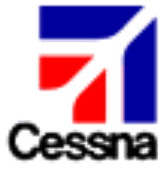 Return to Cessna History Timeline
Return to Cessna History Timeline
. . .
The history of
the
Cessna Citation
business jets

Copyright 2002 by Richard Harris
All Rights Reserved
Not for public consumption.
AUTHOR'S NOTE: This section repeats the story of the FanJet 500 (the original Citation 500), but also includes the story of Cessna's other executive jets: Citation I, II, S/II, III, IV, V, Bravo, Ultra, Encore, Excel, VI, VII, X, CJ, CJ1, and CJ2, and projects future designs in the works.

 It is a high-stakes gamble that pays off fabulously. Shortly after the debut of the Citation -- the most efficient business jet on the market -- America is faced with the 1973-1974 Arab Oil Embargo, which drives fuel prices into the stratosphere. Suddenly, the Citation becomes the much-preferred choice in business jets. With the sudden surge in demand for fuel efficiency, and bolstered by the Citation 500's ease-of-use, short-field capabilities and low purchase price, the modest Citation soon comes to dominate the business-jet market.
It is a high-stakes gamble that pays off fabulously. Shortly after the debut of the Citation -- the most efficient business jet on the market -- America is faced with the 1973-1974 Arab Oil Embargo, which drives fuel prices into the stratosphere. Suddenly, the Citation becomes the much-preferred choice in business jets. With the sudden surge in demand for fuel efficiency, and bolstered by the Citation 500's ease-of-use, short-field capabilities and low purchase price, the modest Citation soon comes to dominate the business-jet market.
Model 500 Citation: (1972) The first production Cessna Citation business jet, originally named FanJet500. Seats 8 (counting the cockpit), and flies about 400mph, up to 1500 miles. It uses the new, small Pratt & Whitney JT-15D turbofan engine. Though somewhat less powerful than the General Electric CJ-610 used in Learjets and other popular bizjets, the engine uses far less fuel, and makes far less noise. The "wide-oval" fuselage is largely patterned on the popular Cessna 400-series propellor twins.
Model 501/502 Citation: (1976) Seats 8 (counting the cockpit), and flies about 400mph, up to 1300 miles. The Citation, with slightly longer wings, and a slightly improved engine. The long "straight" (rather than "swept") wing, and other design features, give the Citation the gentlest handling characteristics of any business jet on the market -- in stark contrast to its chief competitor, the hyper-sensitive Learjet Model 23/24/25. Instruments and controls are designed to make piloting the Citation as easy as possible. As a consequence, the Citation I Model 501 becomes the first -- and (for a while) the only -- business jet FAA-certified for single-pilot operation. This makes the Citation a tempting buy for the rich guy who wants to do his own flying, and makes it an economical choice for the small corporation needing to minimize flight-department costs.
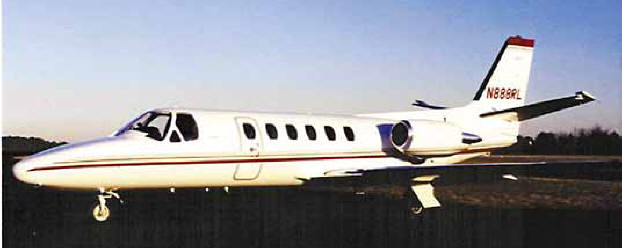 Model 550 Citation II: (1977) A stretched Citation I, permitting an extra three seats (11 in all), powered by slightly larger versions of the JT-15D engine. Carries 11 people at up to 440mph, up to 1,700 miles. Becomes the best selling bizjet of all time -- with over 650 built by 1989. It is also sold to the military in small numbers as the T-47 trainer jet.
Model 550 Citation II: (1977) A stretched Citation I, permitting an extra three seats (11 in all), powered by slightly larger versions of the JT-15D engine. Carries 11 people at up to 440mph, up to 1,700 miles. Becomes the best selling bizjet of all time -- with over 650 built by 1989. It is also sold to the military in small numbers as the T-47 trainer jet.
 Model 650 Citation III: (1983) A radical departure from the small-jet Citation I & II, this is a "mid-size" jet, seating up to 15 (in high-density seating -- though most are delivered with roomy luxury seating for only about 8-12). It has stand-up headroom in the cabin, a swept "supercritical" wing (for maximum speed and efficiency at high altitudes), and a T-tail. It is powered by much-more-powerful Garrett TFE-731 engines, increasingly the preferred engine in the bizjet world.
Model 650 Citation III: (1983) A radical departure from the small-jet Citation I & II, this is a "mid-size" jet, seating up to 15 (in high-density seating -- though most are delivered with roomy luxury seating for only about 8-12). It has stand-up headroom in the cabin, a swept "supercritical" wing (for maximum speed and efficiency at high altitudes), and a T-tail. It is powered by much-more-powerful Garrett TFE-731 engines, increasingly the preferred engine in the bizjet world.
The Citation III is the first Cessna bizjet to challenge the performance and capacity of Sabreliners, Hawkers, Falcons, large Learjets, and other big-and-fast bizjets. Carries 8-15 people at up to 530mph, up to 2,500 miles, giving the plane true ocean-spanning, intercontinental range. With this plane, Cessna hints at an intention to become the dominant force throughout the bizjet market, from the low-end to the top-of-the-line planes.
Citation S/II: (1984) A variant of the Citation II, with improved "supercritical" wings and refined engines, and more cabin headroom and baggage capacity. A modified version would become the T-47A military trainer jet, bought in small quantities by the U.S. military.
Model 560 Citation V: (1989) Another variant of the Citation II, with improved wings and engines, and more cabin headroom and baggage capacity.
Model 650 Citation VI & VII: (1990) A variant of the "stand-up-headroom" Citation III, with improved wings and engines.
 Model 750 Citation X: (1997) The fastest civilian airplane manufactured in the world (since the shutdown of the production line for the Concorde supersonic airliner, a quarter-century ago). Flying at a blistering Mach.92 (92% of the speed of sound, around 650mph), the Citation X can outrun the fastest airliners (other than the supersonic Concorde, of course). Seats 10-15.
Model 750 Citation X: (1997) The fastest civilian airplane manufactured in the world (since the shutdown of the production line for the Concorde supersonic airliner, a quarter-century ago). Flying at a blistering Mach.92 (92% of the speed of sound, around 650mph), the Citation X can outrun the fastest airliners (other than the supersonic Concorde, of course). Seats 10-15.
A basically all-new bizjet, looking like a large Citation III, but with more-severely swept wings and tail, and giant engines (Allison AE3007C's -- typically used on small jetliners). Also includes new, state-of-the-art "glass cockpit" electronics and instrumentation.
 ...
The plane is a surprise hit, particularly with charter companies and "fractional operators" (charter companies that sell shares in their aircraft, like time-sharing condos). This airplane clearly puts the name "Cessna Citation" at the top of the performance list in business aircraft. Helps overcome much of Cessna's traditional image as a low-performance, low-price, slow-plane maker.
...
The plane is a surprise hit, particularly with charter companies and "fractional operators" (charter companies that sell shares in their aircraft, like time-sharing condos). This airplane clearly puts the name "Cessna Citation" at the top of the performance list in business aircraft. Helps overcome much of Cessna's traditional image as a low-performance, low-price, slow-plane maker.
 Model 525 Citation Jet / CJ-I: (1993) A return to the old Citation I, but with improved wings and engines (Williams FJ-44), and a T-Tail. Trailing-link landing gear is included, giving it an advantage over the Citation I in smooth landings. Certified for single-pilot operation. Seats 6-8, 441mph, 1640 mile range.
Model 525 Citation Jet / CJ-I: (1993) A return to the old Citation I, but with improved wings and engines (Williams FJ-44), and a T-Tail. Trailing-link landing gear is included, giving it an advantage over the Citation I in smooth landings. Certified for single-pilot operation. Seats 6-8, 441mph, 1640 mile range.
CJ-II: (1999) A return to the old Citation II, but with improved wings and engines (Williams FJ-44), and a T-Tail. Certified for single-pilot operation. In the same sense that the Citation II is a stretched Citation I, the Citation Jet II is a stretched Citation Jet I.
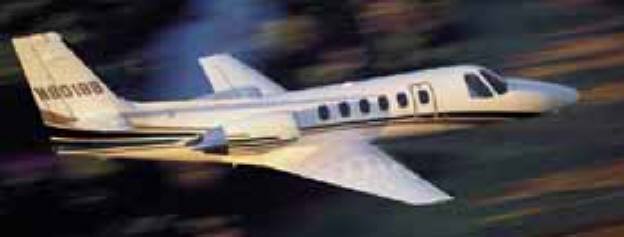 Model 550 Citation Bravo: (1997) Improved model of the Citation V.
Model 550 Citation Bravo: (1997) Improved model of the Citation V.
Model 560 Citation V Ultra: (1997) The Citation Bravo, with bigger engines.
Model 560 Citation Encore: (1997) The Citation Ultra, with bigger engines. The refined Encore is the culmination of the highly successful 560 Series production run. Updated features over its predecessor include heated leading edges, trailing link gear and P&W 535 powerplants delivering increased thrust over the Ultra.
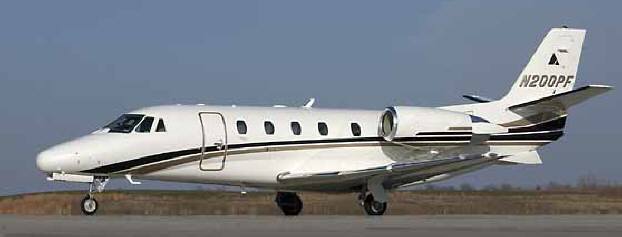 Model 560 Citation Excel: (1997) A return to the "stand-up-headroom" of the Citation III/VII, but with the straight wings and tail, and smaller engines, of the Citation Bravo. Joins the big cabin and imposing "ramp presence" of the bigger 600-series bizjets with the economy and short-field capability of the little, relatively-slow 500-series Citations. One of the more popular Citation designs.
Model 560 Citation Excel: (1997) A return to the "stand-up-headroom" of the Citation III/VII, but with the straight wings and tail, and smaller engines, of the Citation Bravo. Joins the big cabin and imposing "ramp presence" of the bigger 600-series bizjets with the economy and short-field capability of the little, relatively-slow 500-series Citations. One of the more popular Citation designs.
 Citation Sovereign: (expected in 2003) A new "super-midsize" bizjet, designed to compete for the intercontinental bizjet market. Fast and roomy like a Citation VII, but with greater range, and more cabin space. Should be able to span oceans at Mach.82. Will be competing with the Bombardier Continental and Raytheon/Hawker Horizon, and General Dynamics Galaxy G200. With its emphasis on long range, it may also challenge top-of-the-line bizjets, including Bombardier's Challenger and Global Express, along with the traditional favorite, the Gulfstream G-V
Citation Sovereign: (expected in 2003) A new "super-midsize" bizjet, designed to compete for the intercontinental bizjet market. Fast and roomy like a Citation VII, but with greater range, and more cabin space. Should be able to span oceans at Mach.82. Will be competing with the Bombardier Continental and Raytheon/Hawker Horizon, and General Dynamics Galaxy G200. With its emphasis on long range, it may also challenge top-of-the-line bizjets, including Bombardier's Challenger and Global Express, along with the traditional favorite, the Gulfstream G-V
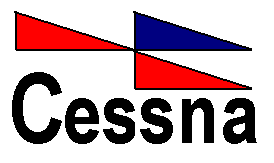 During the Great Recession of 1981-1992, Cessna ends its entire production of propellor-driven aircraft, including all piston and turboprop twins. But its experience with the efficient, popular Citation business jets is just beginning. The Citation line has not only been efficient enough to be a replacement for many of the older Cessna cabin-class twins, but -- in a time of recession -- is the preferred choice for business jets.
During the Great Recession of 1981-1992, Cessna ends its entire production of propellor-driven aircraft, including all piston and turboprop twins. But its experience with the efficient, popular Citation business jets is just beginning. The Citation line has not only been efficient enough to be a replacement for many of the older Cessna cabin-class twins, but -- in a time of recession -- is the preferred choice for business jets.
 Furthermore, during the 1980's, the "Great Recession" of Reaganomics (named for President Ronald Reagan, 1980-1988) radically changes the distribution of wealth in America: the rich get richer, and almost everyone else gets poorer. Consequently, Cessna (like other plane makers) finds it easier (and more profitable) to sell business jets rather than its less-expensive aircraft. Cessna focuses on corporate use, and industrial/airline use of its aircraft. The individual owner/operator is of declining interest to Cessna. Cessna especially focuses on its Citation business jet family, which grows rapidily in the Big Business 1980's. Small wonder, then that the Cessna logo trades in its famous red and blue pennants (above, left) for the symbolic outline of a swept-wing jet (below).
Furthermore, during the 1980's, the "Great Recession" of Reaganomics (named for President Ronald Reagan, 1980-1988) radically changes the distribution of wealth in America: the rich get richer, and almost everyone else gets poorer. Consequently, Cessna (like other plane makers) finds it easier (and more profitable) to sell business jets rather than its less-expensive aircraft. Cessna focuses on corporate use, and industrial/airline use of its aircraft. The individual owner/operator is of declining interest to Cessna. Cessna especially focuses on its Citation business jet family, which grows rapidily in the Big Business 1980's. Small wonder, then that the Cessna logo trades in its famous red and blue pennants (above, left) for the symbolic outline of a swept-wing jet (below).
 Return to Cessna History Timeline
Return to Cessna History Timeline
Return to Aviation Answer-Man Gateway
